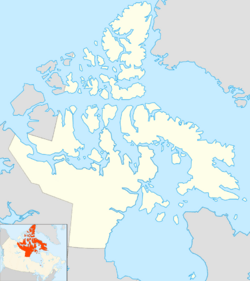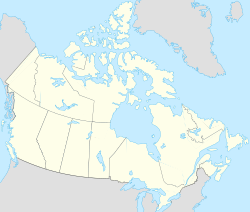Spit Island facts for kids
| Geography | |
|---|---|
| Location | Northern Canada |
| Coordinates | 76°50′N 097°07′W / 76.833°N 97.117°W |
| Archipelago | Queen Elizabeth Islands Canadian Arctic Archipelago |
| Administration | |
|
Canada
|
|
| Territory | Nunavut |
| Demographics | |
| Population | Uninhabited |
Spit Island, also known as Kate Island, is a small piece of land in the far north of Canada. It is part of the amazing Canadian Arctic Archipelago, which is a huge group of islands. This island is located in the territory of Nunavut, a very large and northern part of Canada.
Spit Island lies in a body of water called the Penny Strait. It is found to the west of a much larger island named Devon Island. Like many islands in this cold region, Spit Island is currently uninhabited, meaning no people live there permanently.
Contents
Exploring Spit Island's Location
Spit Island is a tiny spot in the vast Arctic Ocean. It is part of the Queen Elizabeth Islands, which are the most northern islands in Canada. Imagine a map of Canada; Nunavut stretches far into the Arctic, and that is where you would find Spit Island.
Where is Penny Strait?
The Penny Strait is a narrow channel of water. It separates two larger landmasses: Bathurst Island to the west and Devon Island to the east. Spit Island sits right in the middle of this strait. These straits are like watery highways for ice and sometimes even ships.
What is the Canadian Arctic Archipelago?
The Canadian Arctic Archipelago is one of the largest archipelagos in the world. It includes thousands of islands. These islands are mostly covered in ice and snow for much of the year. They are very important for understanding Earth's climate.
Climate and Environment
The weather on Spit Island is extremely cold. It has an Arctic climate. This means long, dark winters and short, cool summers. The sun might not rise for months in winter. In summer, the sun stays up almost all day and night.
Temperatures in the Arctic
Winter temperatures on Spit Island can drop very low. They often go far below freezing, sometimes to -30°C (-22°F) or even colder. Summers are cool, usually just above freezing. The ground often stays frozen all year round, which is called permafrost.
Arctic Landscape Features
The landscape of Spit Island would be rugged and rocky. There would be very little soil. Plants that grow here must be tough. They need to survive the cold and strong winds. You might see small mosses, lichens, and low-growing shrubs.
Wildlife of the Arctic Islands
Even though Spit Island is uninhabited by humans, it is not empty of life. The Arctic is home to many amazing animals. These animals are specially adapted to live in the cold.
Marine Animals Near Spit Island
The waters around Spit Island are rich with marine life. Seals and walruses might swim in the Penny Strait. They use the ice for resting and hunting. Polar bears also roam these areas. They hunt seals on the ice.
Birds of the Arctic
Many types of birds visit the Arctic islands. They come during the short summer months. They use the islands as nesting grounds. Birds like Arctic terns and gulls might be seen flying over Spit Island. They feed on fish from the ocean.
Why Uninhabited Islands Matter
Even small, uninhabited islands like Spit Island are important. They are part of a delicate ecosystem. They help scientists study the environment.
Studying Climate Change
Scientists often study the Arctic. They look at how climate change affects the ice and wildlife. Islands like Spit Island can be natural laboratories. They show how the world is changing.
Protecting Arctic Ecosystems
These islands are also important for conservation. They provide safe places for animals. Protecting these remote areas helps keep the Arctic healthy. It ensures that unique species can thrive.



